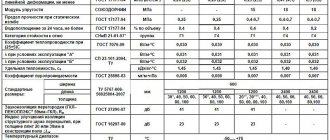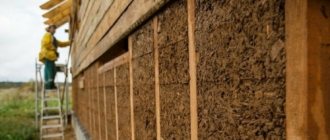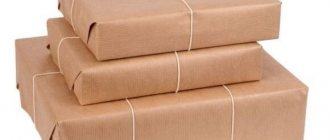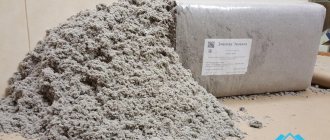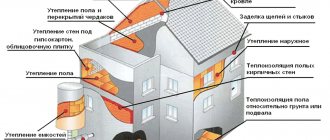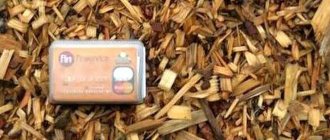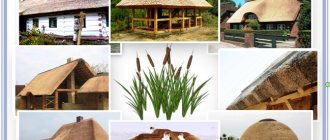What is ecowool? This is the collective name for thermal insulation materials that are made using special technology, often from recycled materials. The material cannot be called new: it has been used since about the middle of the last century and competes with modern types of thermal insulation.
Manufacturers position ecowool as an environmentally friendly material with high performance, which is located in the affordable segment of the construction market. Let's look at how relevant these statements are together.
Table of contents
What are we comparing?
Designed to keep you warm. Seamless installation. Not like fish in water Density and weight Does not burn or does not support combustion? Do you need a vapor barrier? Silence in the home Conclusion Ecowool is a modern thermal insulation material with a low shrinkage rate, good resistance to water, and has high sound insulation properties. A similar characteristic can be found about almost any thermal insulation product, but it is only possible to evaluate how effective the material really is by comparison. In this article we will try to compare ecowool with the most common insulation materials.
Ecowool
Main differences from other insulation materials
The main feature of ecowool is its average performance compared to other insulation materials. It retains heat well, if it is hygroscopic, it does not lose its properties when wet, is durable, and perfectly protects the apartment from noise transmitted through the air. But due to consumers’ poor knowledge of the properties of this material and complex insulation technology, many prefer basalt wool.
To find out which is better, ecowool or basalt insulation, let’s conduct a mini comparison.
- In terms of basic technical characteristics, the insulation materials are approximately equal.
- Both materials do not support open combustion.
- The service life is comparable.
- Due to the absence of seams, cellulose wool retains heat better.
- Ecowool can be used to insulate a surface of any shape and configuration - basalt will have to be cut to fit the protrusions and depressions.
- The insulation technology is much simpler with stone fiber wool.
- The cost of thermal insulation work when insulating a private wooden house is one third more expensive than glass wool insulation, and almost the same when using basalt fiber insulation.
General conclusion: with almost identical costs for insulating a house with cellulose and basalt wool, the owner of the home is freed from work on his own when purchasing cotton wool insulation (performed by professional workers). Ecowool loses to glass wool due to the high cost of work. Otherwise, the choice is up to the consumer.
What are we comparing?
For comparison, let's take insulation materials that are often used to insulate a house: basalt wool and fiberglass-based mineral wool. The choice fell on these materials, since their scope of application is quite wide. They are suitable for insulating walls, floors, roofs, soundproofing partitions, etc.
- Ecowool - 80% consists of cellulose fibers, the raw material for which is recycled paper. The remaining 20% is boric acid and borax. The latter is a fire retardant, which increases the fire resistance of the material. The insulation is made in the form of a loose mixture.
Insulation of the facade using ecowool
- Basalt mineral wool is made from straightened rocks with the addition of phenolic resins; the material is produced in the form of slabs.
Basalt mineral wool has a characteristic brown tint
- Fiberglass mineral wool is made from molten glass or sand. It has a fibrous structure. Often produced in roll form.
Personal protective equipment is required when working with fiberglass
Real consumer reviews we found on the Internet
To better understand the feasibility of ecowool insulation, you can refer to the reviews of people who have already used this material in construction.
Sergey. forumhouse.ru
I bought ecowool to insulate a country house. The workers who were involved in the construction recommended this particular material. The insulation does not require additional layers of vapor and waterproofing, which was the decisive factor. The house has been standing for 3 years now , I have no complaints about the insulation, only positive emotions.
Kirill. vk.com
I don't recommend ecowool. I lived in a house insulated with this insulation for 5 years When I changed my place of residence, the problems disappeared. The doctor said that the body’s reaction was provoked by cellulose (an allergy to paper and library dust).
Note that there may be a case of individual intolerance to the components, so before choosing thermal insulation it makes sense to consult a doctor to avoid unpleasant consequences.
Yuri. otzovik.com
Very pleased with the ecowool. The material fully complies with the declared characteristics, provides reliable insulation, is convenient to use and attracts attention at an affordable price. I found only one drawback: compliance with storage conditions. When exposed to a humid environment, the material becomes covered with a hard crust, which complicates further use.
Also, many users express concerns about the content of borax and boric acid in the insulation. In addition, dissatisfaction is caused by the use of special equipment, but this is a prerequisite for high-quality installation, which cannot be excluded.
Seamless installation.
Ecowool differs from “traditional” heat-insulating materials in the installation method. Basalt mineral wool and fiberglass are produced in rolls or slabs. They are cut into rectangular pieces and laid between joists, sheathing or rafters, depending on the place where the insulation is installed. Installation of ecowool is carried out using the “dry” or “wet” application method. Thanks to this, a continuous insulating layer is obtained without seams or joints. When laying mineral wool and other slab materials, the seams remain “cold bridges”.
The use of specialized equipment allows you to lay ecowool in hard-to-reach places
Ecowool is laid manually or automatically. Manual is more labor-intensive and does not always allow achieving the same insulation density in all areas. Automated installation is carried out through a blowing machine with a corrugated hose. “Wet” or “dry” application method is selected depending on the surface.
When it comes to installation, it is difficult to choose an undisputed leader. On the one hand, the seamless application method allows you to get rid of “cold bridges”; on the other hand, the installation process itself becomes more complicated. In addition, “wet” styling will require drying time (2-3 days).
Ecowool shrinkage
The most common and popular question when the choice falls on this type of insulation. Let's take a closer look here.
To begin with, let's divide the structural elements of the house into 3 groups :
- Horizontal (Floor, attic, ceiling)
- Inclined (Roof, attic)
- Vertical (Walls)
Let's highlight 2 main methods of applying ecowool
- Dry blowing
- Wet glue method
Horizontal surfaces
In this case, the floors are insulated with ecowool. With the help of a regular backfill, it is called “free backfill”, even when ecowool is simply poured onto a hemmed base with a certain layer of insulation and a heat-insulating layer is obtained. Here the density of Ecowool will be about 35 kg/m3.
Insulation of a 200mm floor using the dry backfill method.
With this method of insulation, shrinkage will be about 7-10%. Accordingly, the actual insulation thickness will be approximately 180mm .
Cannot be applied using wet glue method
Sloping surfaces (attics, roof slopes)
It is insulated using the “dry blowing” method. For high-quality non-shrink insulation of the roof with ecowool, it is necessary to properly prepare the base. Let us highlight the main stages of preparation:
- Under an insulated roof, it is necessary to use a vapor-permeable diffusion membrane to allow excess moisture to escape into the ventilation gap. The membrane should be well tensioned, without sagging or damage. Cut-offs must be installed along the lower perimeter of the roof.
Example of a roof before insulation
2. An internal diffusion membrane or vapor barrier is stretched along the straps. To create a rigid internal base and achieve an ecowool density of 50 kg/m3, it is necessary to attach a special retaining plastic mesh over the membrane. and the photo is a prepared roof without insulation
The photo shows a prepared roof without insulation
3. Fill the prepared base with ecowool using dry blowing. There is no need to close the holes in the mesh and membrane.
The process of installing Ecowool insulation on the roof
With this method of installation and preparation of the roof, ecowool is guaranteed not to sag even after a large number of years.
The wet-glue method is not applicable for roof insulation
Not like fish in water
The relationship between moisture and insulating materials can be described as complex. Here we need to return to thermal conductivity again. Under normal conditions, as we have seen, this figure is approximately the same for different thermal insulators, but everything changes when moisture gets on the insulation. All materials behave differently. The most moisture-sensitive material is basalt mineral wool; when moistened by 1%, its thermal conductivity increases by 9–8%. Fiberglass also does not tolerate water well, but recently products with enhanced moisture resistance have begun to appear.
Moisture distribution inside ecowool and mineral wool fibers
What's going on with ecowool? It absorbs water, but thanks to the fibrous structure, all the moisture gets into the fibers, and the empty space with air (which is the main heat insulator) remains free, as a result, when humidified to 20%, the thermal conductivity remains unchanged.
Ultimately, the water resistance parameter is relevant only in the event of force majeure (roof leakage, waterproofing breakthrough, etc.). Subject to compliance with building codes and regulations, water should not get on the insulation, so this indicator should not become decisive when choosing a particular insulation material.
Pros of high capillary activity
- When moistened, the insulating properties of the insulation are preserved.
- Due to the redistribution of moisture through the capillaries, there are no zones of local waterlogging.
This is important when there is some kind of defect in the vapor barrier.
3. Condensation does not form in Ecowool.
4. Ecowool, due to the capillary mechanism, can affect the humidity of the room air. It absorbs excess moisture and releases it when the room becomes dry, that is, like wood fiber, it is a passive regulator of air humidity in the room.
If you do not plan to install supply and exhaust ventilation, then this property will significantly add comfort to your home.
Density and weight
The higher the density of the insulating material, the greater its weight per unit area. With greater weight, the requirements for supporting structures increase. This is especially true when installing a roof. Also, in the case of ecowool, the density is affected by the uniformity of application.
Read about the features of choosing insulation for a roof in the article: “How to insulate a pitched roof.”
- Basalt mineral wool – 25 – 50 kg/m3 depending on the brand
- Fiberglass – 15 – 20 kg/m3
- Ecowool - 35 kg/m3 for horizontal structures and 65 kg/m3 for horizontal ones.
Thus, from the point of view of numbers, the materials do not differ much, but at the same time, applying ecowool to vertical surfaces with insufficient density can lead to subsequent shrinkage. Due to the specifics of application, the density in different areas is not the same.
Ecowool has a high degree of noise absorption
Ecowool is a very good noise-absorbing material in terms of absorbing high and medium frequencies. It works no worse than basalt or fiberglass.
An example of soundproofing a room with Ecowool. Installation was carried out by Ekovata-MSK
When absorbing noise, one must take into account the fact that ecowool is a seamless technology, and in acoustics, as in heating engineering, there are requirements for the tightness of the circuit - any gap or leak is a so-called sound bridge, which significantly impairs the sound insulating ability of the enclosing structure.
Doesn't burn or doesn't support combustion?
Flammability is a parameter that you need to pay close attention to; the overall fire resistance of the entire building depends on it. According to GOST, there are 5 flammability classes: NG (non-flammable), G1 (low-flammable), G2 (moderately flammable), G3 (normally flammable), G4 (highly flammable).
Ecowool does not support combustion, so fire does not spread into the material
- Basalt mineral wool is NG, while slabs containing phenolic binders can emit toxic smoke.
- Fiberglass-based mineral wool is non-flammable, but at temperatures above 500 degrees the material begins to melt, so the flame can spread to other objects.
- Ecowool - G2, upon contact with an open flame, the insulation burns, but does not support combustion (the fire does not spread deep into the material). The advantage is the absence of toxic smoke.
Based on the results of comparing flammability classes, ecowool cannot be called the most fire-resistant material. It should not be used near chimneys, stoves or fireplaces.
Boric acid
Boric acid (orthoboric acid or lat. acidum Boricum) is a weak, monobasic Lewis acid, often used as an insecticide, antiseptic, and fire retardant.
In the photo "Boric acid"
Application
- Boron fertilizer
- Used in laboratories to prepare buffer solutions
- In medicine - as an independent disinfectant for adults, and also in the form of a 2% solution - for washing the skin after contact with alkalis
- Also, various combination preparations are produced based on boric acid (ATX group D08AD), for example Teymurov’s paste
- Registered in the food industry as food additive E284
- In jewelry - as the basis of fluxes for soldering gold-containing alloys
- In everyday life - extermination of cockroaches, ants, bedbugs
- In the production of ceramics, fiber optics, fiberglass, glass
- As a fire retardant to protect wood
- As part of electrolytes for copper and nickel plating
Is vapor barrier necessary?
A vapor barrier protects the insulation in a wall or roof from vapors that escape from the house. Warm air, meeting cold air, condenses at the dew point, which usually falls right on the insulation. As we have already figured out, moisture does not have the most favorable effect on thermal insulation material. You can often come across the opinion that when insulating with ecowool, a vapor barrier is not needed. This is not entirely true, because moisture may not damage the insulation itself, but will cause rotting of other structural elements (walls, sheathing, etc.).
- Basalt mineral wool - vapor barrier needed
- Fiberglass-based mineral wool - vapor barrier needed
- Ecowool - it is recommended to use vapor barrier in places with high humidity.
Origin of cellulose wool
At the beginning of the last century, cellulose wool was appreciated for such properties as reliably retaining heat, absorbing noise and providing decent thermal insulation. After conducting a number of experiments and experiments, in 1929, in the capital of Germany, they began producing cellulose insulation. It began to be actively used in the construction of residential buildings, industrial buildings, private houses and government enterprises.
Cellulose wool found a tangible impetus for rapid popularization and widespread use during the Second World War. During the restoration of a large number of destroyed buildings and houses, a huge amount of insulation and other building materials were required. The demand for a relatively inexpensive material that reliably retains heat and does not allow noise into rooms has increased several times. And, as you know, demand creates supply.
The volumes of insulation used for industrial purposes have become a prerequisite for the emergence of professional blow molding machines, which speed up the installation of thermal insulation and the production of the necessary raw materials.
Conclusion
Based on the results of comparison with other thermal insulation materials, we can highlight the positive and negative aspects of ecowool.
Advantages:
— Seamless application does not form cold bridges.
— Adhesion to the frame provides increased heat and sound insulation.
— Thermal conductivity does not increase when wet
— Good vapor permeability (0.35 mg/(m h Pa)
— Filling hard-to-reach places by blowing cotton wool
— Environmentally friendly - does not contain formaldehyde resins, consists of 80% cellulose
Thermal conductivity Ecowool
Thermal conductivity is the ability of material bodies to conduct energy (heat) from more heated parts of the body to less heated parts of the body through the chaotic movement of body particles (atoms, molecules, electrons, etc.).
The thermal conductivity coefficient of ecowool is 0.039 (W/m*K)
For understanding, below are data on the most common types of insulation.
Thermal conductivity table
The table shows that the thermal conductivity coefficient of ecowool is higher than the average result.
Vertical surfaces (Walls)
Walls are insulated in two ways:
- Dry blowing method
- By wet-adhesive spraying method
Let's look at each of them separately.
Method of dry blowing into walls
For this method it is necessary to create a rigid base, both from the outside and from the inside. It is necessary to ensure the presence of horizontal cutoffs along the perimeter of all walls at a height of approximately 1.5 meters from the floor.
Horizontal cut-off at 1.5 meters from the floor
Next, sew up the walls with any slab material:
- CSP (cement particle board)
- OSB (Oriented Strand Board)
- Beltermo (Insulating fibreboards)
On the other side, sew up with a membrane and a special retaining mesh
The photo shows an example of a wall sewn from the inside
Next, ecowool is blown into the prepared base under a pressure of 65 kg/m3 . With this method of application and preparation of walls, shrinkage of ecowool is guaranteed not to occur.
Wet glue method
With this method of applying ecowool, there is no need to make additional cuts and install a rigid base of the walls on both sides. It is enough to stretch special holding threads inside the walls; they will protect the ecowool from subsequent shrinkage.
Application of ecowool using the wet-glue method
Ecowool consumption with this method is 30-40% higher than with dry blowing. After ecowool has dried, the density will be approximately 55 kg/m3 .
In custody:
Today in Russia there are dozens of enterprises that produce Ecowool, but there is still no GOST or a single standard that would strictly regulate the quality of the material and the technological process. Manufactures operate on the basis of technical specifications that they write for themselves, so the quality can vary greatly.
2 types of Ecowool enterprises in Russia:
the first group is the one that works on a high-performance automated expensive imported production line, for example, Finnish, which specializes in the manufacture of equipment for the production of Ecowool.
The second group of productions are those productions that operate on budget lines of domestic production. In this production chain, as a rule, there may not be automation, no Baratov additives, no dust collection systems, and not a sufficient number of steps for crushing waste newspaper into the required fiber.
Area of use
Ecowool is increasingly used for thermal insulation of objects such as:
- frame houses;
- ceilings, floors and ceilings;
- floors;
- walls;
- cavities, sinuses in attics and attics.
General scheme of use
In the future, experts predict an increase in the applicability of this promising material. As the number of successful applications and the qualifications of operators increases, the popularity of environmentally friendly, high-quality and relatively affordable material on the Russian market is sure to increase.

